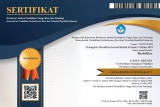Legal Review of The Criminal Act of Murder of Women By Intimate Partners Based on The Provisions of The Act on PKDRT
Abstract
The phenomenon of domestic violence that results in the death of women by intimate partners shows a gap in the legal protection that should be provided by the state. This study examines how Law Number 23 of 2004 concerning the Elimination of Domestic Violence (UU PKDRT) regulates and qualifies murder in domestic relations, and the extent of its effectiveness in implementation. The issues discussed include aspects of normative regulation and the application of law in the field. The methodology applied is normative legal research, using a legislative approach and a case approach. Data sources were obtained through literature studies from laws and regulations, court decisions, and relevant academic opinions, and analyzed qualitatively. The findings show that although the Law on PKDRT contains legal provisions regarding serious physical violence, including that which causes death, its implementation has not been optimal. The low understanding of law enforcement officers, the influence of patriarchal culture, and the lack of protection for victims are the main obstacles. Therefore, integration between the Criminal Code and the Law on PKDRT is needed, as well as increasing the competence of law enforcement officers so that victim protection becomes more effective and just.
Keywords
Full Text:
PDFReferences
Book
Aroma Elmina Martha, Women and Domestic Violence in Indonesia and Malaysia (Yogyakarta: FH UII Press, 2012).
Peter Mahmud Marzuki, “Legal Research Revised Edition” (Bandung: PT. Kharisma Putra Utama, 2015).
Soerjana Soekamto & Sri Mamudji. Normative Legal Research. (Jakarta: Rajawali Pres, 2014), 12.
Journal Articles
Andrian Subarjo & Umar Ma'ruf. "Criminal Investigation Mechanism Involving Children as Perpetrators". LDJ: Law Development Journal 3, No. 1 (2021).
Bernad Arif Sipahutar, “Legal Protection for Women Who Are Victims of Domestic Violence,” Jurnal Rechten: Riset Hukum dan Hak Asasi Manusia 4, no. 1 (2022).
Cipto. “Protection To The Victims of Domestic Violence Crime (Case Study of Kudus Police).” JDF: Jurnal Daulat Hukum 1, No. 4 (2018).
Eka Rinda Wanto, Rakhmat Bowo Suharto, & Siti Rodhiyah Dwi Istimah. "The Capture Process In The Crime of Murder by A Special Team". LDJ: Law Development Journal 4, No. 2 (2022).
Fatah Rafi Ardiansyah, Hamidah Abdurrachman, and Kus Rizkianto, Domestic Violence as a Trigger for Other Criminal Acts (Pekalongan: NEM Publisher, 2024).
Karenina Aulery Putri Wardhani, “Legal Protection for Women Victims of Domestic Violence (KDRT) at the Investigation Level Based on Law No. 23 of 2004 Concerning the Elimination of Domestic Violence (UUPKDRT),” Journal of Legal Research 1, no. 1 (2021).
Muhammad Baharuddin & Akhmad Khisni. “Effectiveness of Pleidooi by The Supreme Of Criminal Murder.” LDJ: Law Development Journal 2, No. 2 (2020).
Napitupulu, CN (2023). Legal Analysis of Domestic Violence Cases According to Law Number 23 of 2004 concerning the Elimination of Domestic Violence (Study of Makassar District Court Decision Number 811/Pid. Sus/2021/PN. Mks) (Doctoral dissertation, Indonesian Christian University).
Raynaldi Arya Danielli. “Analysis of Judge’s Decision on Murder Case in Family Environment (Study in Sleman District Court).” Journal of Atma Jaya University Yogyakarta 1, No. 1 (2016).
Sinawati, V. (2021). Settlement of Domestic Violence (KDRT) Cases Through Customary Institutions (Case Study of Gampong Mulia, Kuta Alam District, Banda Aceh City) (Doctoral dissertation, UIN Ar-raniry).
Sopacua, Margie Gladies. “The Ideal Concept of Preventing Domestic Violence Against Women.” Indonesian Legal Development Journal 4, no. 2 (2022)
DOI: https://doi.org/10.21107/ri.v20i1.30566
Refbacks
- There are currently no refbacks.

Rechtidee is licensed under a Creative Commons Attribution-ShareAlike 4.0 International License.
Indexing and Abstracting:












